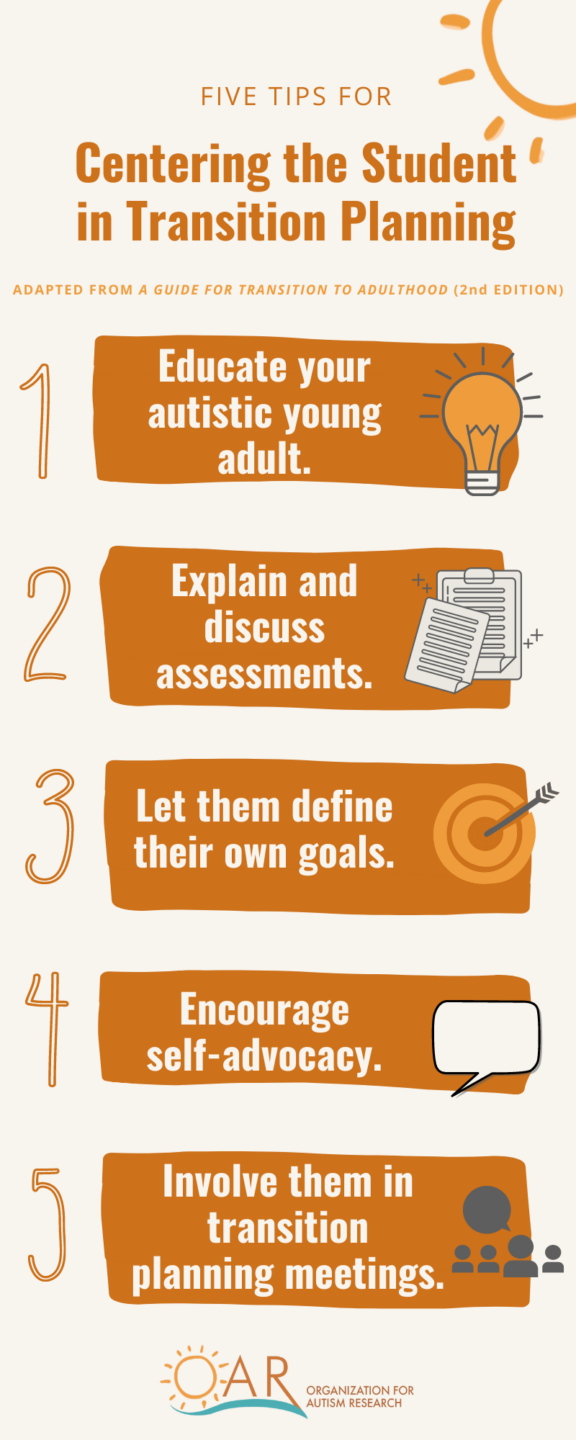5 Tips for Centering the Student in Transition Planning
September 08, 2021
How can parents and educators foster self-determination skills in autistic young adults and engage in student-centered transition planning?
Student-centered planning, also called “person-centered planning,” is an approach to transition planning that prioritizes the interests and aspirations of the individual student. Specifically, the focus is on helping students develop the tools and skills necessary to design their own goals for their career, education, living situation, and other aspects of adult life. The team builds the transition plan around the student’s goals by equipping the student with the tools and resources needed to reach those goals. In addition to helping the team create purposeful and specific plans for their life after graduation, the student’s involvement in the transition planning process also provides them with an excellent opportunity to advocate for themselves.
These 5 tips, adapted from OAR’s newly updated Guide for Transition to Adulthood , can provide guidance for anyone embarking on the transition planning journey.
1. Educate your autistic young adult. An autistic young adult needs to know how having autism may impact them, including both strengths and challenges, in settings from education to employment to the community. Understanding autism in this way and being able to express its personal impact in their own words will help them educate others, advocate for themselves, and build a realistic transition plan. Additionally, connecting with the autistic community can help young adults understand that they are not alone and get advice from others who have been through similar situations.
2. Help your autistic young adult to understand the results of their assessments. Many assessments are involved in developing IEPs and transition plans. However, the results of these assessments need not be hidden from autistic young adults or mystifying to them. Reviewing the results of their assessments with your autistic young adult will help them get a better sense of their strengths, weaknesses, and interests. Ask the young adult to self-assess their own qualities as well. Also, encourage the transition team to use interview-style assessments that focus on the student’s goals.
3. Allow your autistic young adult to define their own goals to the extent possible. Autistic young adults may require varying levels of help in determining how to choose goals and in identifying their interests and strengths across specific areas. Guiding the student through this process ensures that they are in control of their future and helps them develop a sense of agency – feeling empowered to act on their own behalf. Chapter 3 of OAR’s Guide for Transition to Adulthood (2nd Edition) provides several worksheets that parents and autistic young adults can complete together in order to identify goals.
4. Encourage your young adult to advocate for themselves and their needs in social and educational situations. Self-advocacy is not limited to transition planning meetings only, and it is a skill that must be grown and developed over time. Whenever possible, encourage autistic children and young adults to speak for themselves and complete tasks independently. Chapter 3 of OAR’s Guide for Transition to Adulthood (2nd Edition) includes an activity that parents and autistic young adults can complete together to support the development of self-advocacy skills.
5. Involve your autistic young adult in IEP/ITP meetings. Meaningfully including the student in these meetings is an essential aspect of student-centered planning. This kind of involvement requires preparation – both providing predictability to the student to minimize surprise and anxiety and making sure that the student has time to prepare what they want to say and ask, as well as to request any necessary accommodations. The checklist included in Chapter 3 of OAR’s Guide for Transition to Adulthood (2nd Edition) can help structure the preparation process. In the meeting itself, make sure all participants address the student directly and ensure that the student understands the discussion. Be mindful that each individual young adult may be comfortable with a different level of participation.
 Click here to download this infographic as a PDF.
Click here to download this infographic as a PDF.
This article is adapted from the 2021 edition of A Guide for Transition to Adulthood.